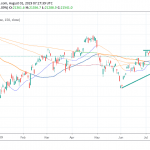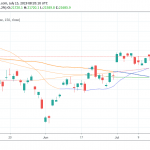- News of an oil price war added fuel to the market’s jittery sentiment and caused equities and risk currencies to plunge in today’s Asian session.
News of an oil price war added fuel to the market’s jittery sentiment and caused equities and risk currencies to plunge in today’s Asian session. The Nikkei 225 closed at its lowest level in more than a year at 19,698.54, down 5.07% or 1,051.14 points. Meanwhile, the Shanghai Composite Index was down by 3.01% or 91.221 points at 2,943.291. The Hang Seng Index is also seeing some selling pressure. It is trading 4.38% or 1,149.2 points lower at 25,003.0. Australia’s stock index, S&P/ASX 200, closed with a 7.33% or 455.6-point loss at 5,760.6.
The biggest news over the weekend is Saudi Arabia’s announcement of an oil price war. Last week, OPEC+ talks broke down after Russia refused to agree to additional production cuts. The proposal was meant to provide support for crude oil price which had lost more than 20% since January. In response, Saudi Arabia announced that it will increase its production to over 10 million barrels and began offering discounted prices to its oil.
This should have been welcome news to consumers. However, the coronavirus outbreak is not showing any sign of stopping. This means that demand for the commodity as well as growth will likely remain to be muted despite lower prices.
Aside from implications of political uncertainty, investors are now worried about the prospect of deflation. Lower prices (from crude oil) and sluggish growth (as the coronavirus continues to disrupt business activity) would leave central bankers in a tough position.
As for the major currencies, USDJPY is the biggest loser. It is down by over 3% in today’s Asian session as risk aversion has triggered a flight to the Japanese yen. USDCAD, on the other hand, is up by 1.64%, Meanwhile, AUDUSD is down by over 1.50%.
Read our Best Trading Ideas for 2020.
AUDUSD Outlook
On the monthly time frame, AUDUSD can be seen testing its 2009 lows around 0.6300. Reversal candlesticks around this price could indicate that there are buyers in the market. They could soon push AUDUSD to its December 2015 lows at 0.6990 and test it for resistance. On the other hand, a strong bearish close below 0.6300 could mean that the currency pair has room to trade lower. The next support level is at the 0.6000 handle where AUDUSD bottomed on October 2008.




